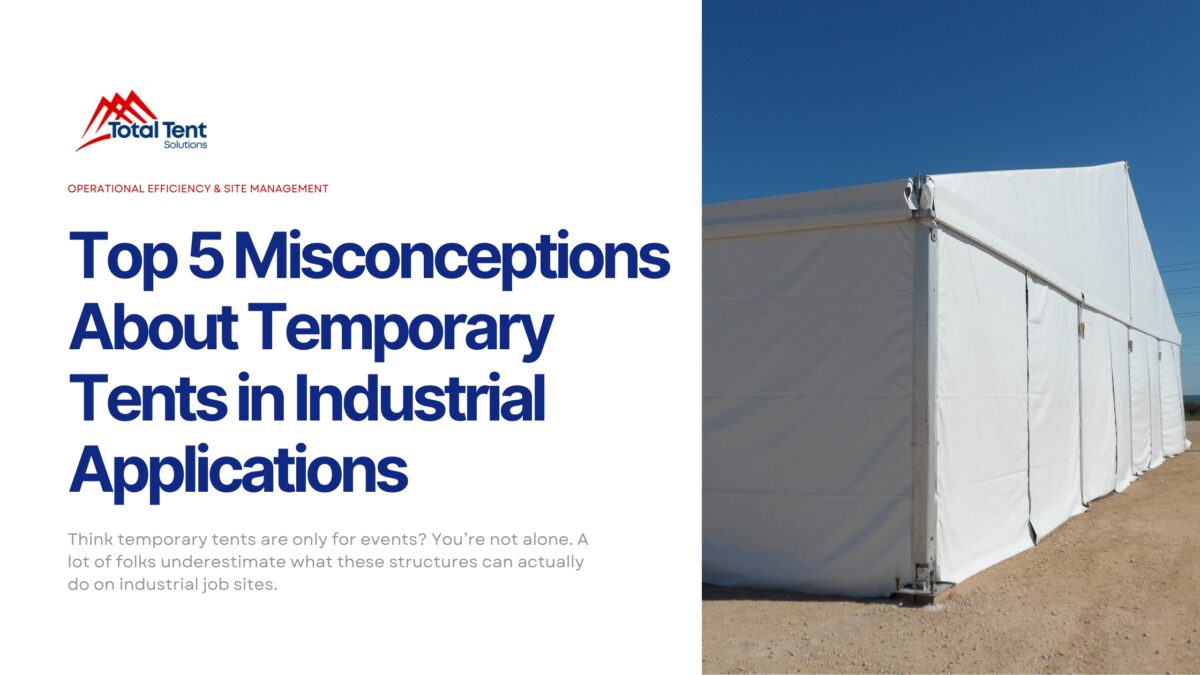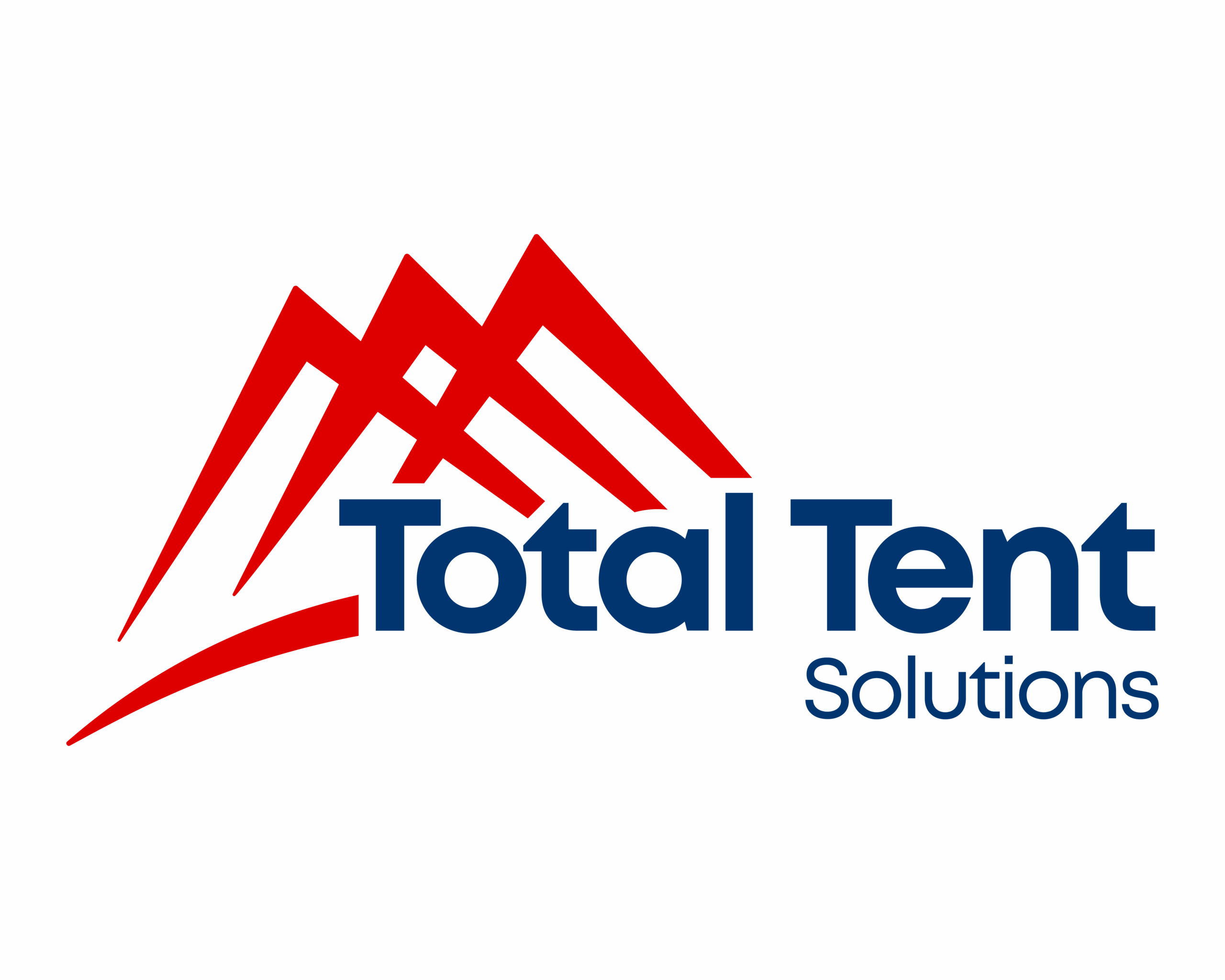
Let’s face it. When people hear the word “tent,” their minds usually jump to weddings, county fairs, or weekend festivals. That’s understandable. After all, most of us don’t see tents outside of special events. But in the world of industrial construction, petrochemical turnarounds, and infrastructure projects, temporary tents are unsung heroes.
Unfortunately, there are some stubborn myths out there that keep decision-makers from fully embracing what these structures can do. So, let’s shine a light on the top five misconceptions about temporary tents in industrial applications and why it’s time to rethink how we use the word “temporary.”
Misconception #1: Temporary Tents Are Only for Events
Industrial sites are not “one-day” parties
The biggest and most persistent myth? That tents are only good for backyard barbecues and corporate events. It’s easy to see why. Many of us picture white canvas stretched over a few poles and think, “There’s no way that works on a job site.” But industrial tents are a whole different breed.
Real-world use cases in oil, gas, and construction
In reality, these structures are hard at work across the country, serving as everything from on-site break tents to full-scale fabrication enclosures. They offer covered spaces for welding, painting, sandblasting, equipment storage, and even mobile command centers.
Need somewhere to house 200 workers for lunch breaks in the middle of a refinery turnaround? A temporary tent can do that. Need a climate-controlled area for coating pipe sections or housing expensive instrumentation? Yep, a tent can do that too.
This isn’t about throwing up some shade. It’s about purpose-built, engineered structures that solve real industrial problems quickly and efficiently.
Misconception #2: They’re Flimsy and Can’t Handle Harsh Weather
Built to take a beating
This one’s especially common in areas where weather can be unpredictable. It’s easy to assume that a temporary structure won’t stand up to wind, rain, or extreme heat. But modern industrial tents are designed to be anything but fragile.
Wind load ratings and engineered structures
These aren’t pop-up canopies. They’re engineered to meet specific wind and snow load requirements, often exceeding 70 or even 100 mph, depending on location and local building codes. The aluminum or steel frames are designed to flex and absorb stress without compromising the structure. Fabric panels are reinforced and UV-resistant, with coatings that resist tears, fire, and moisture.
In fact, many tent systems are certified by licensed engineers who understand the demands of your job site and the risks of non-compliance.
Real talk: How these tents hold up in storms and high temps
We’ve seen these tents in hurricane-prone Gulf Coast regions and in blazing desert environments out west. With proper anchoring and preparation, they stay put and do their job, protecting crews and equipment no matter what’s happening outside.
So no, they’re not flimsy. They’re more like mobile bunkers with natural light.
Misconception #3: Installation Takes Forever
Set up in days, not weeks
Here’s another myth that gets in the way: that these structures take too long to install. The truth? With an experienced crew and the right planning, many tents can be up and operational in just a few days. Sometimes within 24 hours. It’s not magic. It’s just smart design and good logistics.
How site readiness and planning impact install time
Of course, it helps when the site is prepped. Flat, accessible ground speeds things up. Knowing ahead of time whether you’ll need power drops, anchoring into asphalt or concrete, or heavy equipment access is key. But once the crew rolls in, things move quickly.
If you’re working with a provider that does this every week, you’ll be shocked at how fast they move. It’s like watching a NASCAR pit crew, but for tents.
What to expect from a full-service tent provider
Full-service providers take care of everything: permitting, delivery, installation, HVAC setup, lighting, flooring, and more. That means fewer headaches for your team and more time focused on the actual project. Many even offer 24/7 support if you’re working around the clock.
So while you might be thinking this could take a week or two, the truth is, you could be operational in a day or two.
Misconception #4: Tents Are a One-Size-Fits-All Solution
Every site is different
Let’s bust another one: the idea that a tent is just a tent, and you get what you get. In industrial work, one-size-fits-all never works. Your project is unique, and your shelter should be too.
Modular customization: flooring, walls, lighting, HVAC
Temporary tents today are modular by design. That means you can adjust the size, shape, and functionality to fit your exact needs. Want solid sidewalls instead of fabric? Need high ceilings for crane access? How about separate zones inside for crew meals, storage, and first aid?
You can add flooring that supports forklifts and heavy machinery. You can bring in LED lighting, ducted HVAC, negative air pressure zones, and even sound-dampening panels. If it feels like a permanent facility inside, that’s the point.
Real examples of site-specific solutions
We’ve seen tents used as mobile labs for environmental testing, complete with power, water, and workstation layouts. Others serve as staging areas for offshore projects where every square foot of organized shelter counts.
Bottom line: you don’t adapt your job site to the tent. You adapt the tent to your job site.
Misconception #5: They’re a Temporary Fix, Not a Long-Term Solution
Temporary doesn’t mean short-term
This one trips people up because the word “temporary” can be misleading. Just because something is permitted as a temporary structure doesn’t mean it’s only good for a few days.
Use cases where tents last for years
Many industrial tents are installed for projects that span months or even multiple years. We’re talking about warehousing, staging areas, and fabrication bays that stay in place through multiple phases of construction or recurring shutdowns. As long as they’re maintained, they’re not going anywhere.
Maintenance and durability insights
Maintenance is minimal but important. Most providers offer check-ups, especially after severe weather. Frames are rust-resistant. Fabric is easy to clean and replace. And if you need to relocate? Many tent systems are modular enough to disassemble, move, and reassemble at the next project site. So whether you need it for six weeks or six years, these tents are built to last.
What’s Actually True About Temporary Industrial Tents?
Designed with safety and compliance in mind
Let’s not forget the most important part: safety. Industrial tents are built with compliance in mind. That includes everything from OSHA standards to NFPA 701 flame resistance ratings. They’re built to keep your crew safe and your operations running smoothly.
Meet OSHA, fire code, and environmental standards
You’ll find features like clear egress paths, fire exits, rated materials, proper ventilation, and safety signage built into the design. And if your site has environmental restrictions or emissions requirements, a good provider knows how to work within those limits. In other words, this isn’t their first rodeo.
How to Choose the Right Provider
It’s about more than just the tent
Choosing the right partner can make or break your experience. You’re not just buying a product. You’re buying a service. And you need someone who understands the pace and pressure of industrial work.
What to look for in a partner: experience, certifications, and support
Look for providers with a track record in your industry. Bonus points if their crews are TWIC-certified or hold regional safety council credentials. Make sure they can provide references, help with permitting, and offer maintenance plans if the tent will be up long-term. A great provider will feel like a partner, not a vendor.
Conclusion: Time to Bust the Myths
Tents might not be the first thing that comes to mind when you think about industrial infrastructure, but maybe they should be. Today’s temporary structures are strong, fast, flexible, and built for real work.
So let’s retire the idea that they’re just for parties or quick fixes. In reality, they’re tools, just like scaffolding, cranes, or site trailers. When used right, they’re absolute game-changers.
Next time someone scoffs at using a tent for a serious project, ask them this: Why wouldn’t you want something this fast, this flexible, and this tough?
FAQs
Are temporary tents safe for use in hazardous job sites?
Yes, many industrial tents are designed with hazardous environments in mind. They can be equipped with flame-retardant materials, negative air pressure zones, and even spark-resistant ventilation systems.
Can temporary tents be insulated for extreme heat or cold?
Definitely. Insulated panels, thermal liners, and powerful HVAC systems can turn a tent into a comfortable workspace even in extreme climates.
How do temporary tents compare to permanent buildings in cost?
They’re significantly cheaper upfront and much faster to deploy. Plus, there’s no long-term tax or real estate implication since they’re classified as temporary structures.
What kind of maintenance do industrial tents require?
Not much. Periodic inspections, basic cleaning, and checking the tension of the fabric and anchoring systems are usually enough. Most issues can be fixed quickly with minimal disruption.
Can you relocate a tent if your project moves?
Yes. One of the biggest benefits is mobility. Tents can be taken down, moved, and reinstalled at a new site with relatively little hassle, which is perfect for companies with multiple job sites.

